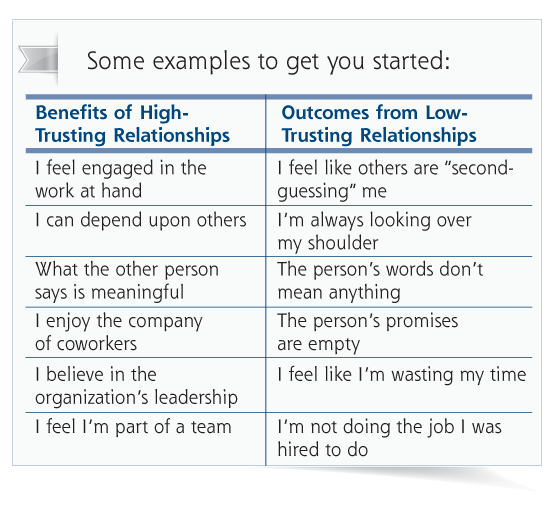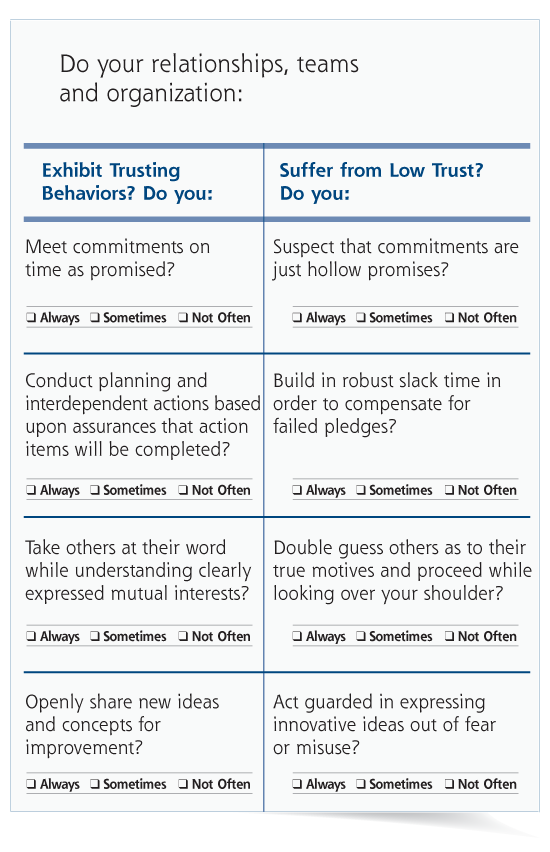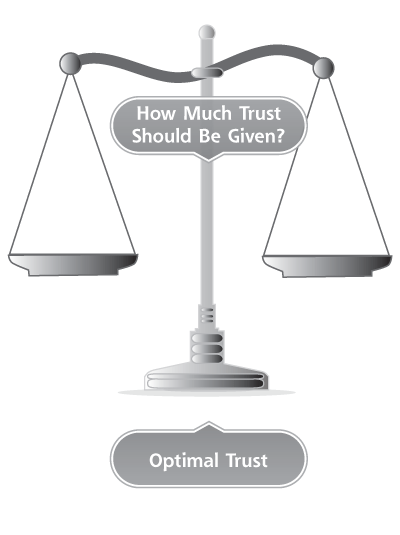
The Value of Trust in the Workplace
 What is it?
What is it?
A comparison of high-trusting relationships versus low-trusting relationships will lead you to understand the importance of trust.
What does it do?
- Illustrates the impact of trust within your work environment.
- Helps you evaluate the benefits of high-trusting relationships.
- Helps you evaluate the cost of low-trusting relationships.
How do I do it?
- From your personal perspective, make a list of the benefits of high-trusting relation-ships. Why do you gravitate to relationships where high trust exists? What are the payoffs of having high-trusting relationships in your life?
- Make a list of negative outcomes from low-trusting relationships you have in your life. Think of several relationships that suffer from lack of trust and ask yourself what the costs are, what opportunities have been lost, and the time that has been wasted due to the state of the relationship. You may be surprised by the total impact of low-trusting relationships.

Definition of Trust
Trust is the ingredient that allows people to have faith that what is being said can be relied upon. Call it “making good on a promise,” or “walking the talk,” or “doing what you say you will do,” when you come through, you’ve started to build trust. When commitments are made, the belief that the product or services will be delivered as stated frees up the mental capacity devoted to worry and doubt. Relationships, teams, and organizations that are operating well, that is to say are high-trusting, save time and money when trust is firmly established.
What is the Value of Trust?
Trusting Behaviors Versus Lack of Trust
In the table below, which column, left or right, has the highest number of “Always” or the highest number of “Not Often”? Do you exhibit trusting behaviors or suffer from low trust? Use this simple table to assess specific relationships you have in the workplace, or other people you have relationships with.

The Costs of Low Trust and No Trust: Time, Money and Effort
When trust is either absent or at a low level within the workplace, both the work and employees struggle.

Finding the Optimal Level of Trust
Understanding that trust is required within the work environment, does that mean all resources should be expended to develop trust at the highest level? Considering a scale of 1–10, with 1 being extremely low and 10 being the highest level of trust you have ever experienced, should all relationships strive to be a 10? In a word, NO.

The concept of optimal trust speaks to the notion that in every relationship and work environment there is a favorable level of trust that allows for outstanding performance. The optimal level with your boss may be at an 8, with a coworker in another department a 6. The key is to determine the best level of trust to develop within different contexts.
Consider the optimal level of trust with a co-worker versus your boss, with a secondary supplier versus a committed customer. Since trust requires energy and investment to create, working toward the optimal level in every relationship delivers the best overall performance.
Bring to mind a scale, with the optimal level of trust for a particular relationship represented on one end and the trust investment on the other. Are you creating the optimal level of trust in your relationships or are you “under-investing”?